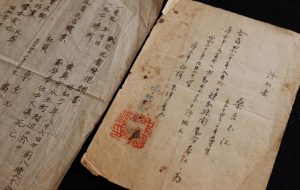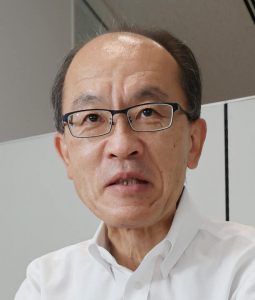Family of Chugoku Shimbun employee who died in A-bombing donates certificate as evidence of labor on August 6, requests continued A-bomb reporting
Aug. 2, 2023
by Kyoko Niiyama, Staff Writer
A certificate issued by the Chugoku Shimbun for one of its employees, Tamae Kuwabara, who died in the atomic bombing, had been kept by a member of her family. The certificate serves as evidence that Tamae, 20 at the time of the A-bombing, engaged in the work of demolishing buildings to create fire lanes on August 6, 1945. The certificate was kept on hand by her younger brother, Ikuto, who died in 2012, as a remembrance of his sister, whose remains have never been found. The piece of paper also serves as a ‘witness’ communicating the catastrophic damage incurred by the media organization, which lost 114 employees, or around one-third of its staff, in the bombing.
The palm-sized certificate reads, “This is to certify that the person named was sent to Kakomachi, Hiroshima City, on August 6 to engage in the work of demolishing buildings to create fire lanes for the war effort.” Dated September 24, 1945, it contains the official seal of the Chugoku Shimbun with the words ‘Mukainada’ (indicating the name of a district) and “Toyo Kogyo” (present-day Mazda Motor Corporation). Amid the chaos after the bombing, the newspaper relocated some of its operations to the Toyo Kogyo offices in Mukainada for a time, given that its head office building, located about 900 meters from the hypocenter, had burned to the ground. A family member of Tamae apparently presented the certificate when reporting her death to the Hiroshima City office.
After Ikuto died, his oldest son, Hideo, 65, who lives in Hiroshima’s Higashi Ward, held on to the certificate. “For my father, the certificate probably served as evidence of Tamae’s existence. He never showed it to us, though, while he was alive.” Hideo found it by accident when he was organizing the things his father had left behind. There was also a post-mortem report that included a company seal, but those details are unclear.
Tamae’s family consisted of four people, including Tamae herself; Chikano, her mother; Ikuto, her brother who was two years her junior; and Koko, her younger sister. Tamae was assigned to the news-type division at the newspaper, arranging lead type for the different Japanese written characters from cases on shelves to compose news articles for printing.
Seventy-eight years ago, Japan had been placed on war footing. On August 6, Tamae was on the right bank of the Motoyasu River, an area to the south side of Peace Memorial Park, located in Hiroshima’s Naka Ward, about 500 meters from the hypocenter, as a member of the Chugoku Shimbun Volunteer Citizens’ Corps. Made up of newspaper and news agency employees in Hiroshima, the corps were there to tear down buildings and create fire lanes. There is evidence of 45 staff members from the Chugoku Shimbun being at that location. All of those workers, including Tamae, were killed.
In the Kuwabara family, Koko, who also was out working as a mobilized student, seems to have been killed instantly, and Chikano was seriously wounded in the area of Hakushima-cho (now part of Hiroshima’s Naka Ward). Ikuto experienced the atomic bombing at Hiroshima Station. Although he would never speak about his A-bombing experience to his family, Ikuto agreed to be interviewed by the newspaper’s labor union in 1987 and revealed, “Until she breathed her last, my mother was concerned about the circumstances involving my sister.”
Hideo, who lives in the house where Tamae was born, holds on to photographs of her while she was still alive. She is smiling in photos taken on the roof of the Chugoku Shimbun head office building, which was located where the Hiroshima Mitsukoshi Department Store now stands. A monument for the newspaper workers who were victims of the atomic bombing (‘Renunciation of war monument’) stands near the site where Tamae experienced the bombing. Several years ago, Hideo started attending the annual memorial services held in front of the monument on the anniversary of the atomic bombing, based on the idea that he only knew his aunt “from photographs.”
In addition, he recently donated the certificate and the post-mortem report to the Chugoku Shimbun. Because there are no documents about employees who died in the bombing remaining at the news organization, the donated materials are considered to be valuable from the perspective of informing people of the starting point of the media in the city following the atomic bombing. Hideo told the journalist who interviewed him, “Please continue to report on the atomic bombing so there will be no more victims like my aunt.”
(Originally published on August 2, 2023)
A certificate issued by the Chugoku Shimbun for one of its employees, Tamae Kuwabara, who died in the atomic bombing, had been kept by a member of her family. The certificate serves as evidence that Tamae, 20 at the time of the A-bombing, engaged in the work of demolishing buildings to create fire lanes on August 6, 1945. The certificate was kept on hand by her younger brother, Ikuto, who died in 2012, as a remembrance of his sister, whose remains have never been found. The piece of paper also serves as a ‘witness’ communicating the catastrophic damage incurred by the media organization, which lost 114 employees, or around one-third of its staff, in the bombing.
The palm-sized certificate reads, “This is to certify that the person named was sent to Kakomachi, Hiroshima City, on August 6 to engage in the work of demolishing buildings to create fire lanes for the war effort.” Dated September 24, 1945, it contains the official seal of the Chugoku Shimbun with the words ‘Mukainada’ (indicating the name of a district) and “Toyo Kogyo” (present-day Mazda Motor Corporation). Amid the chaos after the bombing, the newspaper relocated some of its operations to the Toyo Kogyo offices in Mukainada for a time, given that its head office building, located about 900 meters from the hypocenter, had burned to the ground. A family member of Tamae apparently presented the certificate when reporting her death to the Hiroshima City office.
After Ikuto died, his oldest son, Hideo, 65, who lives in Hiroshima’s Higashi Ward, held on to the certificate. “For my father, the certificate probably served as evidence of Tamae’s existence. He never showed it to us, though, while he was alive.” Hideo found it by accident when he was organizing the things his father had left behind. There was also a post-mortem report that included a company seal, but those details are unclear.
Tamae’s family consisted of four people, including Tamae herself; Chikano, her mother; Ikuto, her brother who was two years her junior; and Koko, her younger sister. Tamae was assigned to the news-type division at the newspaper, arranging lead type for the different Japanese written characters from cases on shelves to compose news articles for printing.
Seventy-eight years ago, Japan had been placed on war footing. On August 6, Tamae was on the right bank of the Motoyasu River, an area to the south side of Peace Memorial Park, located in Hiroshima’s Naka Ward, about 500 meters from the hypocenter, as a member of the Chugoku Shimbun Volunteer Citizens’ Corps. Made up of newspaper and news agency employees in Hiroshima, the corps were there to tear down buildings and create fire lanes. There is evidence of 45 staff members from the Chugoku Shimbun being at that location. All of those workers, including Tamae, were killed.
In the Kuwabara family, Koko, who also was out working as a mobilized student, seems to have been killed instantly, and Chikano was seriously wounded in the area of Hakushima-cho (now part of Hiroshima’s Naka Ward). Ikuto experienced the atomic bombing at Hiroshima Station. Although he would never speak about his A-bombing experience to his family, Ikuto agreed to be interviewed by the newspaper’s labor union in 1987 and revealed, “Until she breathed her last, my mother was concerned about the circumstances involving my sister.”
Hideo, who lives in the house where Tamae was born, holds on to photographs of her while she was still alive. She is smiling in photos taken on the roof of the Chugoku Shimbun head office building, which was located where the Hiroshima Mitsukoshi Department Store now stands. A monument for the newspaper workers who were victims of the atomic bombing (‘Renunciation of war monument’) stands near the site where Tamae experienced the bombing. Several years ago, Hideo started attending the annual memorial services held in front of the monument on the anniversary of the atomic bombing, based on the idea that he only knew his aunt “from photographs.”
In addition, he recently donated the certificate and the post-mortem report to the Chugoku Shimbun. Because there are no documents about employees who died in the bombing remaining at the news organization, the donated materials are considered to be valuable from the perspective of informing people of the starting point of the media in the city following the atomic bombing. Hideo told the journalist who interviewed him, “Please continue to report on the atomic bombing so there will be no more victims like my aunt.”
(Originally published on August 2, 2023)










